
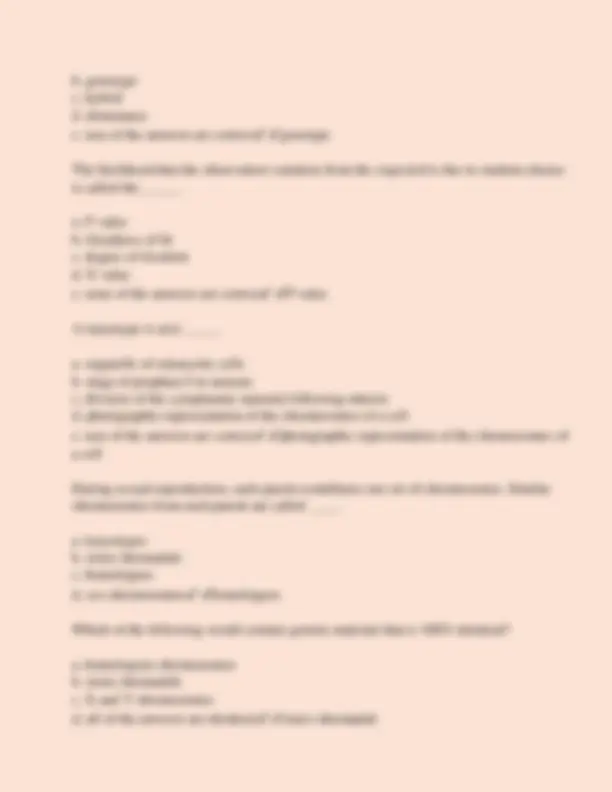
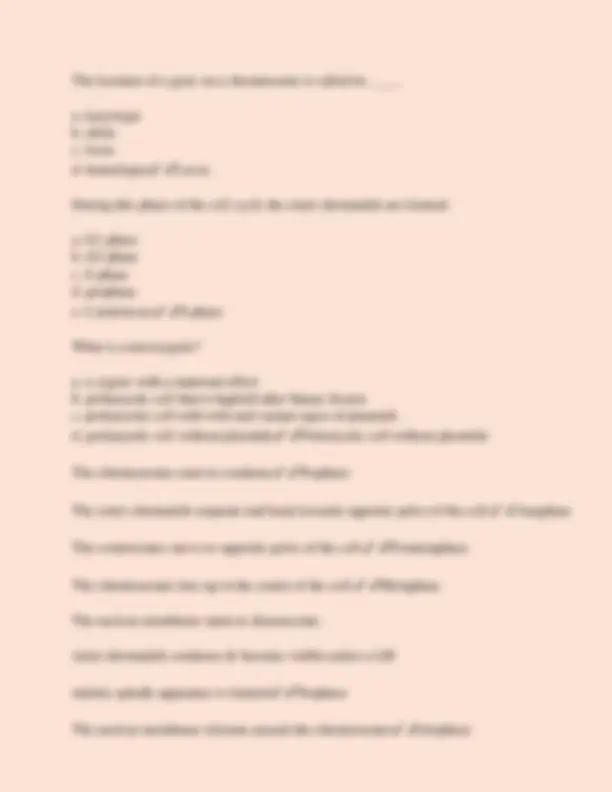
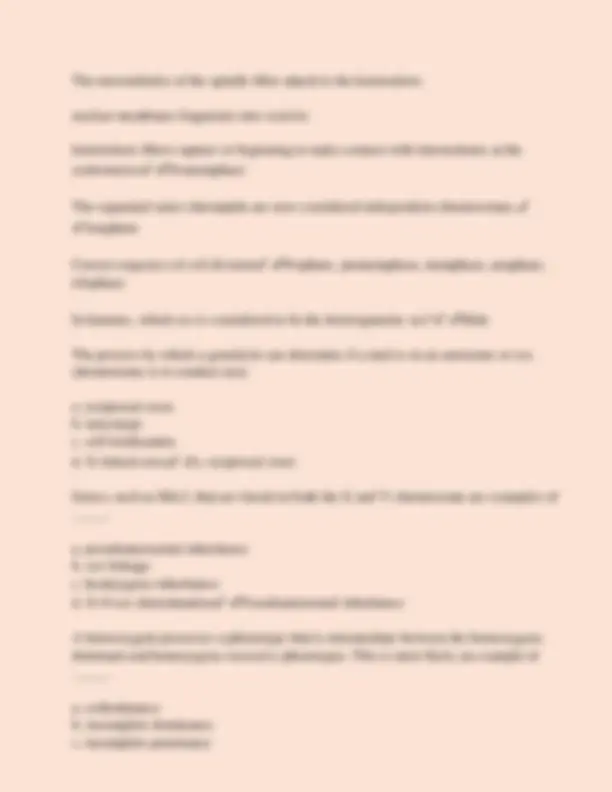
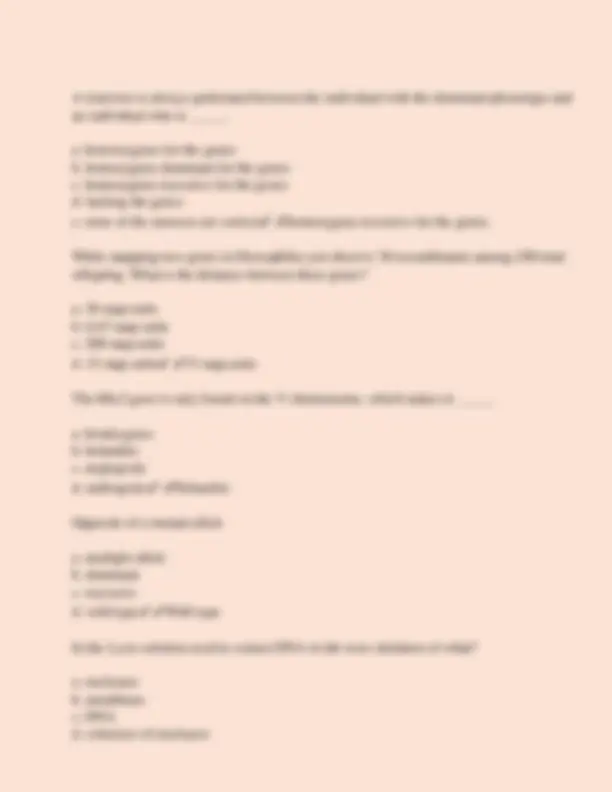
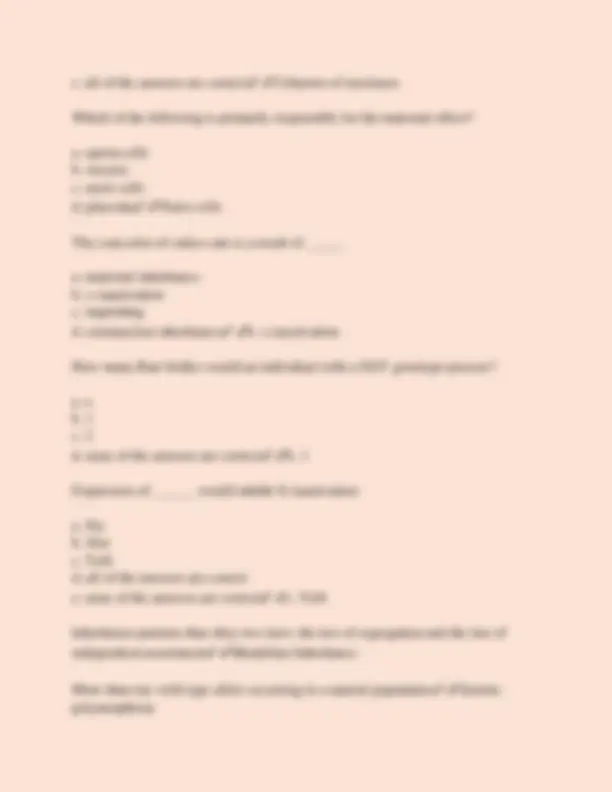
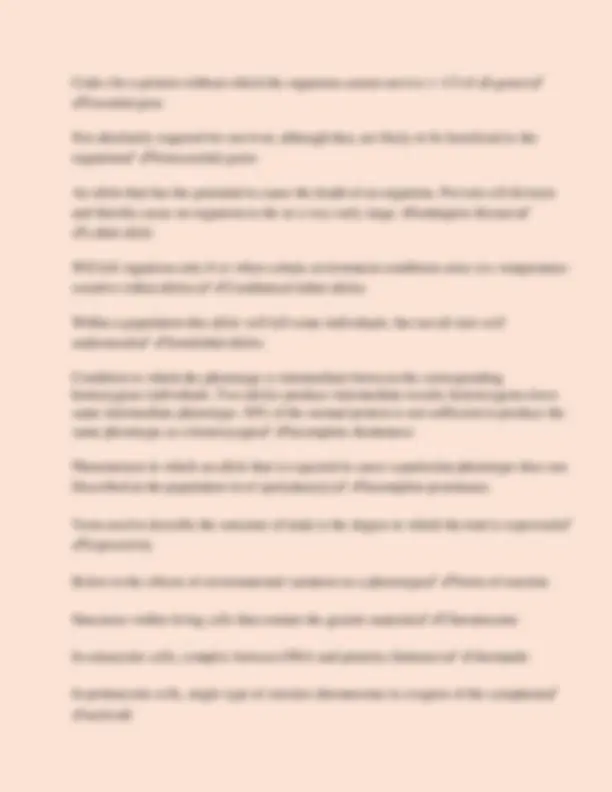
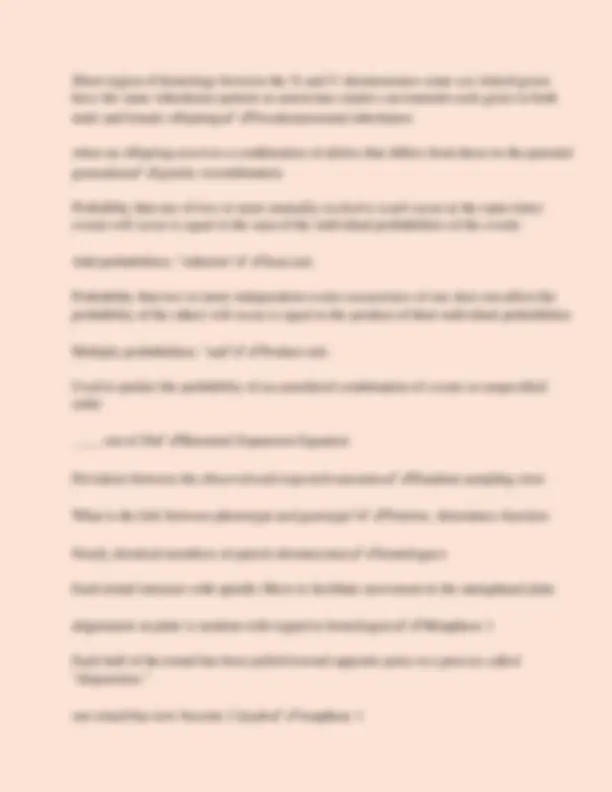
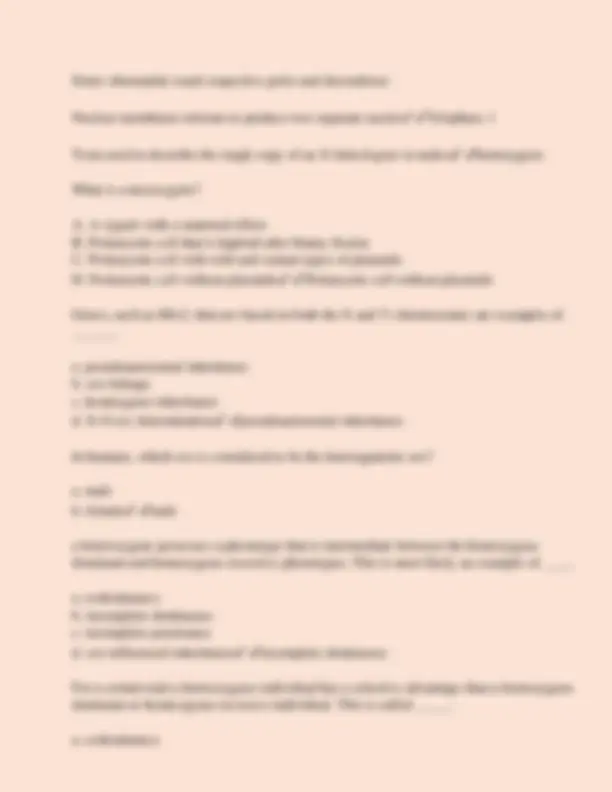
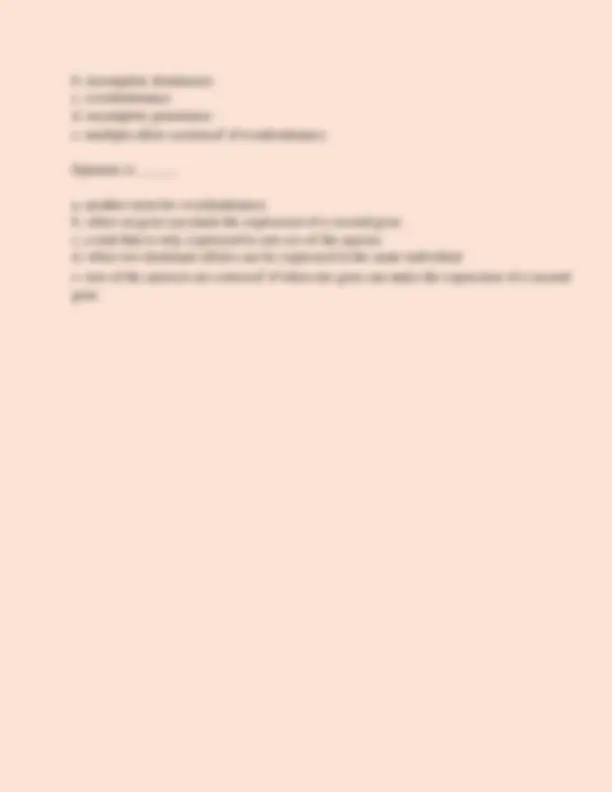


Study with the several resources on Docsity

Earn points by helping other students or get them with a premium plan


Prepare for your exams
Study with the several resources on Docsity

Earn points to download
Earn points by helping other students or get them with a premium plan
Community
Ask the community for help and clear up your study doubts
Discover the best universities in your country according to Docsity users
Free resources
Download our free guides on studying techniques, anxiety management strategies, and thesis advice from Docsity tutors
A comprehensive overview of fundamental genetics concepts, including gene structure, function, and inheritance patterns. It explores key terms like genotype, phenotype, and allele, and delves into the mechanisms of dna replication and cell division. The document also includes multiple-choice questions that test understanding of these concepts, making it a valuable resource for students studying genetics.
Typology: Quizzes
1 / 15

This page cannot be seen from the preview
Don't miss anything!










What is genetics? ✔ ✔study of genes and what they do; branch of biology that deals with heredity and variation Root of the natural diversity that we observe among members of the same species as well as among different species✔ ✔Genetic variation Gene✔ ✔"Unit of heredity", usually described according to the way it affects the traits or characteristics of an organism How many genes are there? ✔ ✔Around 30,000-35, How much of the genome is coded for? ✔ ✔less than 5 % What is the largest cellular molecule in humans?✔ ✔DNA Categories of larger cellular molecules: ✔ ✔Nucleic acids (DNA, RNA), Proteins, Carbohydrates and lipids Proteome✔ ✔All the proteins that a cell makes at a given time Constitutive Gene✔ ✔Unregulated; different cell types; transcribed continually; different types Housekeeping Gene✔ ✔Ongoing business; histones; continually made; can control (turn on/off) housekeeping depending on growth cycle Inducible✔ ✔Gene that can be turned on or off; produces proteins on a continual basis Genetic Code✔ ✔DNA sequences within most genes contain the information to direct the order of amino acids within polypeptides Which codon is the least conserved? ✔ ✔Last Does every gene code for a protein? ✔ ✔NO! tRNA, rRNA, mRNA
When studying a genetic cross, the second generation following the initial cross is identified by which of the following? a. P generation b. F1 generation c. F2 generation d. F3 generation e. P3 generation✔ ✔F2 generation A true bredding line of green pod pea plants is crossed with a true-breeding line of yellow pod plants. All of their offspring have green pods. From this information, it can be stated that the green color is_____. a. recessive b. dominant c. subservient d. blended e. non of the answers are correct✔ ✔dominant When Mendel crossed two plants that were heterozygous for a single trait, what was the phenotypic ratio of their offspring? a. 1 : 2 : 1 b. 9 : 3 : 3 : 1 c. 3 : 1 d. 7 : 4 e. varied depending on the trait✔ ✔3: An individual who has two identical alleles for a trait is said to be _____. a. homozygous b. heterozygous c. isozygous d. a variant✔ ✔homozygous The genetic composition of an individual is called its _____. a. phenotype
The location of a gene on a chromosome is called its ____. a. karyotype b. allele c. locus d. homologue✔ ✔Locus During this phase of the cell cycle the sister chromatids are formed. a. G1 phase b. G2 phase c. S phase d. prophase e. Cytokineses✔ ✔S phase What is a merozygote? a. a zygote with a maternal effect b. prokaryotic cell that is haploid after binary fission c. prokaryotic cell with wild and variant types of plasmids d. prokaryotic cell without plasmids✔ ✔Prokaryotic cell without plasmids The chromosomes start to condense✔ ✔Prophase The sister chromatids separate and head towards opposite poles of the cell.✔ ✔Anaphase The centrosomes move to opposite poles of the cell.✔ ✔Prometaphase The chromosomes line-up in the center of the cell.✔ ✔Metaphase The nuclear membrane starts to disassociate. sister chromatids condense & become visible under a LM mitotic spindle apparatus is formed✔ ✔Prophase The nuclear membrane reforms around the chromosomes✔ ✔telophase
The microtubules of the spindle fiber attach to the kinetochore. nuclear membrane fragments into vesicles kinetochore fibers capture or beginning to make contact with kinetochores at the centromeres✔ ✔Prometaphase The separated sister chromatids are now considered independent chromosomes.✔ ✔Anaphase Correct sequence of cell division✔ ✔Prophase, prometaphase, metaphase, anaphase, telophase In humans, which sex is considered to be the heterogametic sex?✔ ✔Male The process by which a geneticist can determine if a trait is on an autosome or sex chromosome is to conduct a(n): a. reciprocal cross b. karyotype c. self-fertilization d. X-linked cross✔ ✔a. reciprocal cross Genes, such as Mic2, that are found on both the X and Y chromosome are examples of _____. a. pseudoatuosomal inheritance b. sex-linkage c. hemizygous inheritance d. X-O sex determination✔ ✔Pseudoautosomal inheritance A heterozygote possesses a phenotype that is intermediate between the homozygous dominant and homozygous recessive phenotypes. This is most likely an example of _____. a. codominance b. incomplete dominance c. incomplete penetrance
a. sex-limited inheritance b. sex-influenced inheritance c. incomplete dominance d. simple Mendelian inheritance e. incomplete dominance✔ ✔Sex-influenced inheritance Epistasis is _______. a. another term for overdominance b. when one gene can mask the expression of a second gene c. a trait that is only expressed in one sex of the species d. when two dominant alleles can be expressed the same individual e. none of the answers are correct✔ ✔When one gene can mask the expression of a second gene. A woman who is heterozygous for X-linked baldness marries a man who is nonbald. Which of the following would be true of their offspring? a. all would be bald b. all of the females would be nonbald, all males would be bald c. all of the females would be nonbald and 1/2 of the females would be bald d. 1/2 of females would be bald and 1/2 of the females would be bald e. all would be nonbald✔ ✔All of the females would be nonbald, 1/2 of the males would be bald Which of the following statistical tests is used to determine if two genes are linked or assorting independently? a. sum rule b. binomial expansion c. product rule d. chi-square test✔ ✔chi-square test Crossing over is more likely to occur between genes that are ____ on a chromosome. a. close together b. far apart✔ ✔far apart.
A testcross is always performed between the individual with the dominant phenotype and an individual who is _____. a. heterozygous for the genes b. homozygous dominant for the genes c. homozygous recessive for the genes d. lacking the genes e. none of the answers are correct✔ ✔homozygous recessive for the genes. While mapping two genes in Drosophilia you observe 30 recombinants among 200 total offspring. What is the distance between these genes? a. 30 map units b. 6.67 map units c. 200 map units d. 15 map units✔ ✔15 map units The Mic2 gene is only found on the Y chromosome, which makes it _____. a. hemizygous b. holandric c. angiogenic d. androgenic✔ ✔Holandric Opposite of a mutant allele a. multiple allele b. dominant c. recessive d. wild type✔ ✔Wild type In the Lysis solution used to extract DNA in lab were chelators of what? a. nucleases b. membrane c. DNA d. cofactors of nucleases
Codes for a protein without which the organism cannot survive (~1/3 of all genes)✔ ✔Essential gene Not absolutely required for survival, although they are likely to be beneficial to the organism✔ ✔Nonessential genes An allele that has the potential to cause the death of an organism. Prevent cell division and thereby cause an organism to die at a very early stage. (Huntington disease)✔ ✔Lethal allele Will kill organism only if or when certain environment conditions arise (ex: temperature- sensitive lethal alleles)✔ ✔Conditional lethal alleles Within a population this allele will kill some individuals, but not all (not well understood)✔ ✔Semilethal alleles Condition in which the phenotype is intermediate between the corresponding homozygous individuals. Two alleles produce intermediate results; heterozygotes have same intermediate phenotype. 50% of the normal protein is not sufficient to produce the same phenotype as a homozyogte✔ ✔Incomplete dominance Phenomenon in which an allele that is expected to cause a particular phenotype does not. Described at the population level (polydactyly)✔ ✔Incomplete penetrance Term used to describe the outcome of traits is the degree to which the trait is expressed✔ ✔Expressivity Refers to the effects of environmental variation on a phenotype✔ ✔Norm of reaction Structures within living cells that contain the genetic material✔ ✔Chromosome In eukaryotic cells, complex between DNA and proteins (histones)✔ ✔chromatin In prokaryotic cells, single type of circular chromosome in a region of the cytoplasm✔ ✔nucleoid
Nearly identical members of paired chromosomes✔ ✔Homologues Increases cell size, RNA, and proteins✔ ✔G Chromosomes doubled (sister chromatids)✔ ✔S phase Further cell growth and protein synthesis✔ ✔G2 phase Object of mitosis✔ ✔to evenly distribute replicated chromosomes into two daughter cells with each nuclei having a complementary chromosomes Gametes of equal size, structure and motility✔ ✔Isogamous Gametes different in size, structure, and motility✔ ✔Heterogamous Larger non-motile egg; smaller motile sperm✔ ✔Oogamous Chromosomes begin to condense and become visible with a light microscope chromosomes begin to search nucleus for their homologue often takes on a horse shoe shape; ends associated with proteins on nuclear lamina✔ ✔Leptotena Homologous chromosomes recognize and align themselves along their entire lengths (synapsis) two pairs of aligned or associated sister chromatids are referred to as bivalents or tetrads✔ ✔Zygotena In most eukaryotic species, a synaptonemal complex (binding of lateral elements via transverse filaments) is formed between homologous chromsomes during synapsis, crossing over occurs; recombinant DNA✔ ✔Pachytena Synaptonemal complex disappears
Short region of homology between the X and Y chromosomes some sex-linked genes have the same inheritance pattern as autosomes (males can transmit such genes to both male and female offspring)✔ ✔Pseudoautosomal inheritance when an offspring receives a combination of alleles that differs from those in the parental generation✔ ✔genetic recombination Probablity that one of two or more mutually exclusive (can't occur at the same time) events will occur is equal to the sum of the individual probabilities of the events Add probabilities; "either/or"✔ ✔Sum rule Probability that two or more independent events (occurrence of one does not affect the probability of the other) will occur is equal to the product of their individual probabilities Multiply probabilities; "and"✔ ✔Product rule Used to predict the probability of an unordered combination of events or unspecified order ____ out of 20✔ ✔Binomial Expansion Equation Deviation between the observed and expected outcomes✔ ✔Random sampling error What is the link between phenotype and genotype?✔ ✔Proteins. determines function Nearly identical members of paired chromosomes✔ ✔homologues Each tetrad interacts with spindle fibers to facilitate movement to the metaphasal plate alignement on plate is random with regard to homologues✔ ✔Metaphase 1 Each half of the tetrad has been pulled toward opposite poles in a process called "disjunction." one tetrad has now become 2 dyads✔ ✔Anaphase 1
Sister chromatids reach respective poles and decondense Nuclear membrane reforms to produce two separate nuclei✔ ✔Telophase 1 Term used to describe the single copy of an X-linked gene in males✔ ✔hemizygous What is a merozygote? A. A zygote with a maternal effect B. Prokaryotic cell that is haploid after binary fission C. Prokaryotic cell with wild and variant types of plasmids D. Prokaryotic cell without plasmids✔ ✔Prokaryotic cell without plasmids Genes, such as Mic2, that are found on both the X and Y chromosomes are examples of ______. a. pseudoautosomal inheritance b. sex-linkage c. hemizygous inheritance d. X-O sex determination✔ ✔pseudoautosomal inheritance In humans, which sex is considered to be the heterogametic sex? a. male b. female✔ ✔male a heterozygote possesses a phenotype that is intermediate between the homozygous dominant and homozygous recessive phenotypes. This is most likely an example of ____. a. codominance b. incomplete dominance c. incomplete penetrance d. sex-influenced inheritance✔ ✔incomplete dominance For a certain trait a heterozygous individual has a selective advantage than a homozygous dominant or homozygous recessive individual. This is called _____. a. codominance